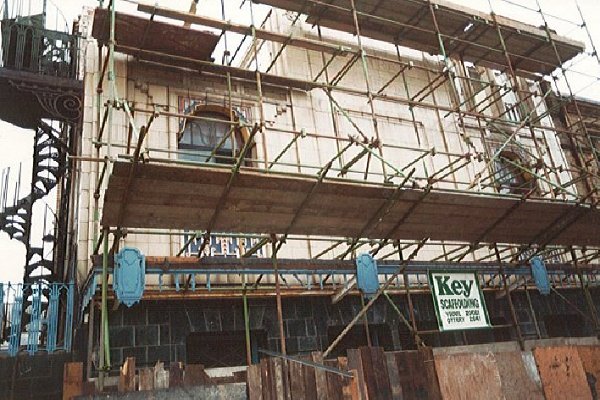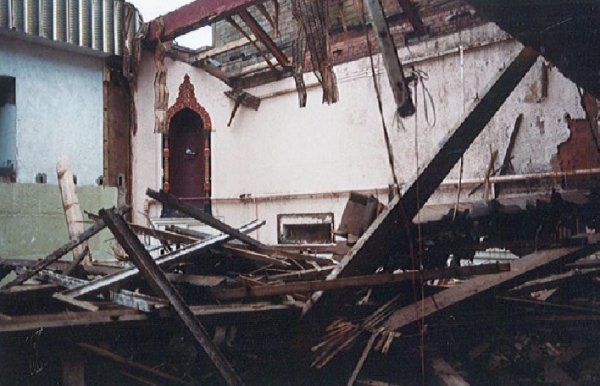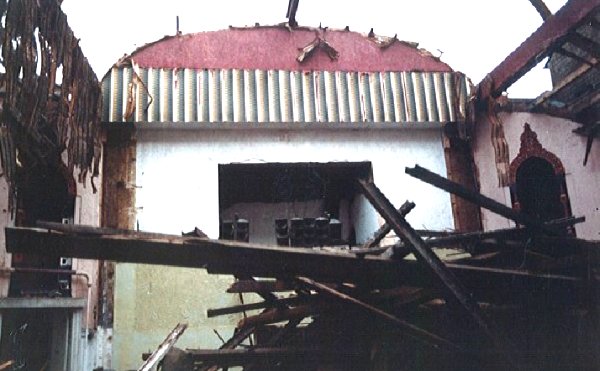central cinema
central cinema
Yeovil's first cinema
The Central Auction Rooms was owned by Mr Archie Thring, a member of the Thring family who owned the glove factory in Waterloo Lane. Regular auctions of surplus furniture, bankrupt stock, fire-damaged goods, etc., were held in this single-storey hall, and it was also let for public whist drives, concerts, dances, and meetings whose promoters could not afford the charges for the Assembly Rooms or Town Hall. It was sometimes used by the Operatic Society as a rehearsal room.
The first public showing of a film in Yeovil was at the Assembly Rooms in Princes Street in 1896 but the Central Auction Rooms in Church Street followed in 1912. It was re-named "Yeovil's Cosy Corner" by 1915 but, as seen in the advertisement below, by 1916 Alfred Sugden was the manager, and Archie Thring had renamed it the Central Hall Cinema. In his advertisement Thring gave his cinema the strapline "The Oldest-Established Picture House in the District" omitting to mention that it was the oldest by only one year.
In order to convert the premises into a picture house, very little alteration was made to the original building. It was fitted with rather spartan seating, the more expensive ones on a raised platform at the rear. Entrance and escape was by a passageway at the side, which led to primitive toilets at the rear and also to the projection room. This was like a large box, made of sheet iron, and housed the projector and the highly inflammable films. The operator was Bert StClair, the teenage son of the manager of the ‘Palace’. As there was no public electricity supply in Yeovil at that time, the current for lighting and projection was supplied by a rather temperamental old gas engine driving a dynamo by pulleys and belt.
Ventilation was very basic, and periodic spraying with disinfectant could never disguise the prevailing odours of stale tobacco smoke, wet clothing and sweaty socks. A pianist provided appropriate music throughout the programme, and the charge for admission varied; the nearer the screen the cheaper the seat.
The cinema had wooden benches at the front with more comfortable seats further back and there was one performance each evening, two on Saturdays plus a Saturday afternoon matinée. Mr H Hellias recalled in the 1970s "I well remember going there before the First World War and paying one penny for the Saturday afternoon shows and we were given a bag of sweets."
By the 1920s children paid 2d and adults paid 6d for admission. Again in the 1970s, Mrs PR Young recalled "My father was the projectionist for the silent films.... My mother was the cashier and my sister and I went to the Saturday matinées for 2d. The Thring family were the owners." Another remembered "I also recall going to the Central Cinema to see films on Saturday afternoons, as my father took the tickets and kept an eye on the children. Mr Len Bollen ran the films at the back of the hall and the screen was on the front wall. One must not forget the pianist and I believe Mr Archie Thring owned it."
During the night of Saturday 24 / Sunday 25 May 1930 a fire broke out in the cinema. Mr Thring, the proprietor, was found in his office suffering from smoke inhalation and with badly burned hands. He was taken to hospital and later made a full recovery. The now-gutted cinema, however, was not so lucky with the fire causing such extensive damage that a complete rebuild was necessary. Part of the roof of the adjoining St John's schoolrooms was damaged but repairable. The cause of the fire was never discovered.
The rebuilt Central Cinema opened in January 1932. Designed in an art deco neo-Egyptian style by Douglas Langford, an Exeter architect, the new cinema could accommodate 560 patrons. The front elevation was clad in faience tiles and the columns between the top floor windows had lotus bud capitals. An external helical steel staircase on the side of the building provided the only access for the projectionist to get to the projection room. The cinema boasted a lighting system with a 60-colour change and a ventilation and air cooling system capable of changing the air completely three times an hour.
Despite the opulence of the new building this small, independent cinema faced fierce competition during the 1930s from nearby rivals, the Gaumont and the Odeon, both of which were huge in comparison. After the Second World War the central cinema was forced to have continuous screenings on a daily basis from 2:10pm each day and charges were increased to between 9d and 1s 10d. During the 1950s the widespread introduction of television into people's homes bought about a general decline in the cinema industry. The Central Cinema finally closed its doors on 8 August 1964. There was a brief revival when the building was used as a casino, called the 'Yeovil Central Casino' although this didn't last long. The building was then used as a bingo hall, called the 'Yeovil Central Bingo Club', but this venture ceased in 1979.
The building was left to rot and then gutted. It remained empty until it was finally demolished, despite protests, in January 1983.
gallery
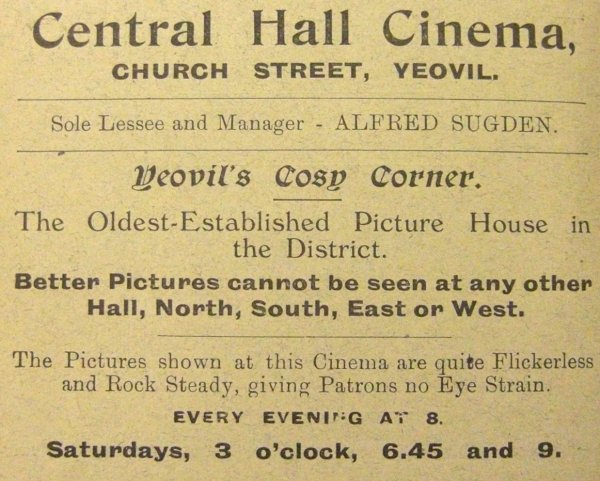
Advertisement for the Central Hall Cinema from Whitby's Yeovil Almanack Advertiser of 1916. The manager, Alfred Sugden, gave it the sobriquet "Yeovil's Cosy Corner".
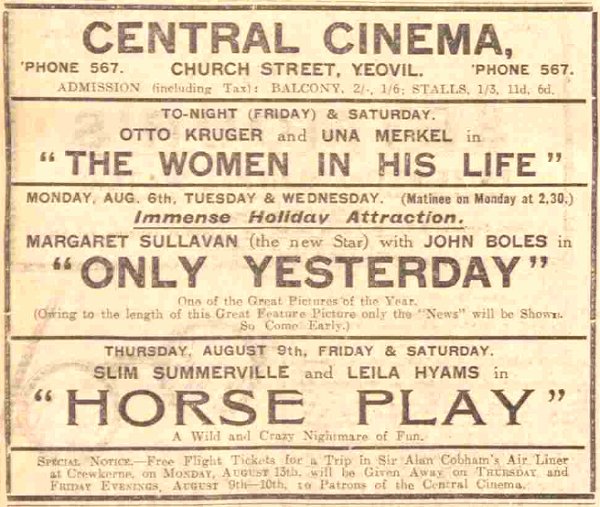
An advertisement in the Western Gazette edition of 3 August 1934, displaying the week's rapidly-changing programme at the Central Cinema, as well as prices.

The new Central Cinema, rebuilt after the disastrous fire, and seen here from Princes Street in a colourised photograph of the 1930s.
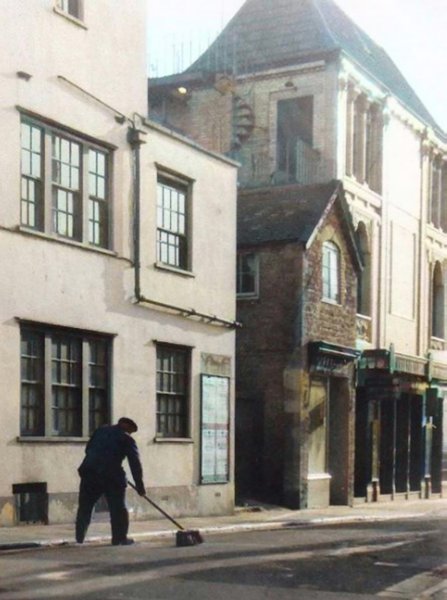
This
colourised photograph
features in my
book "Lost Yeovil"
An evocative image of a road sweeper in Church Street, probably photographed in the 1950s, with the Central Cinema at right.
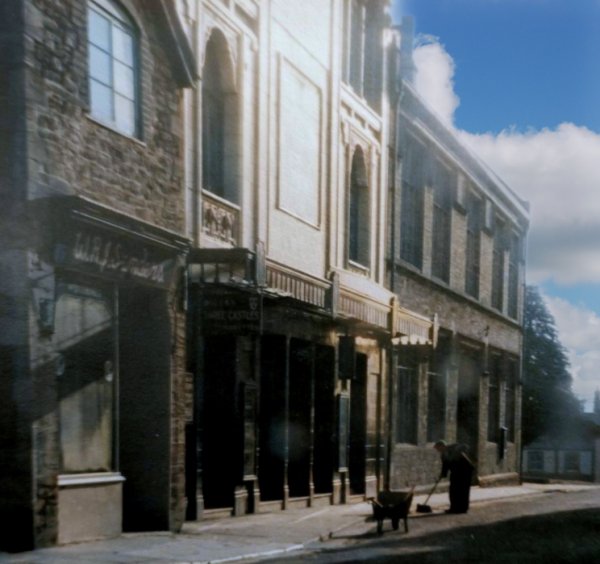
Photo by Bernard
White
(colourised). Courtesy of South Somerset Heritage Collection
Again, photographed in the early 1950s. Is that the same road sweeper?
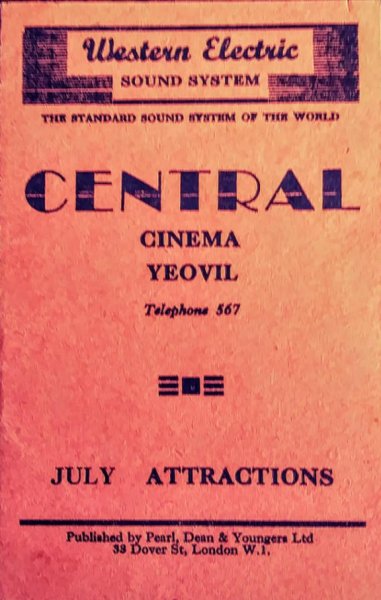
Courtesy of
Derek Sherry
The front of a monthly list of film showings from 1955.
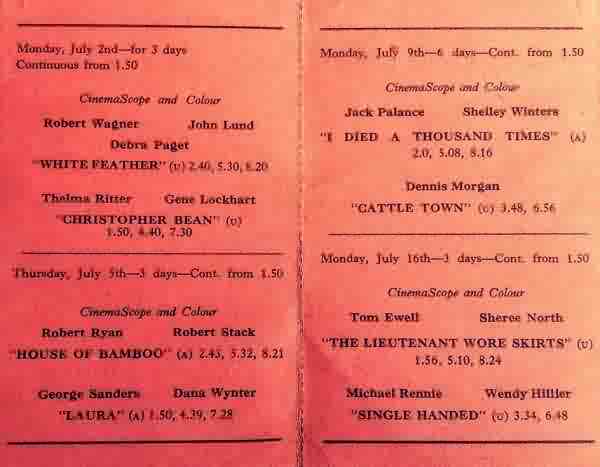
Courtesy of
Derek Sherry
.... and the films being shown at the Central Cinema in July 1955.
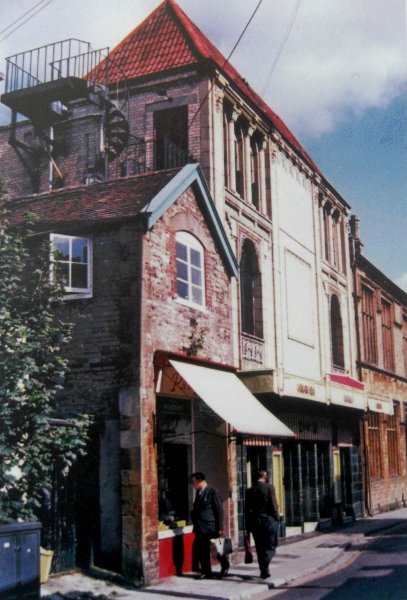
Courtesy of
Rob Baker
A colour photograph of the Central Cinema, probably dating to the 1960s.
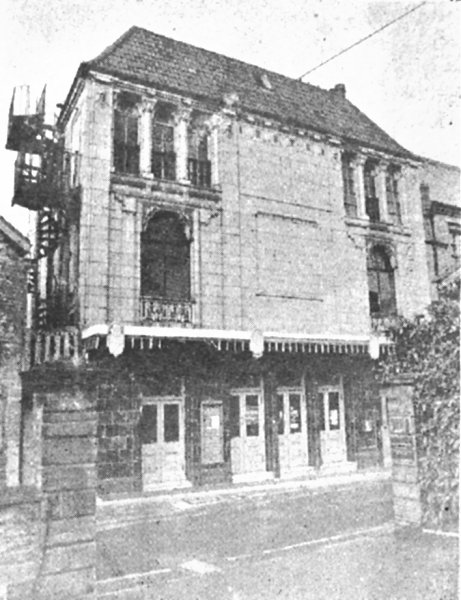
Courtesy of
Rob Baker
A more frontal view of the Central Cinema, scanned from a newspaper dating to the 1970s.
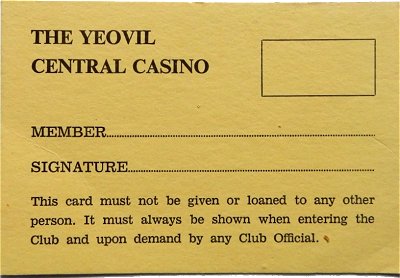
From my
collection
A membership card of the short-lived 'Yeovil Central Casino' of the late 1960s.
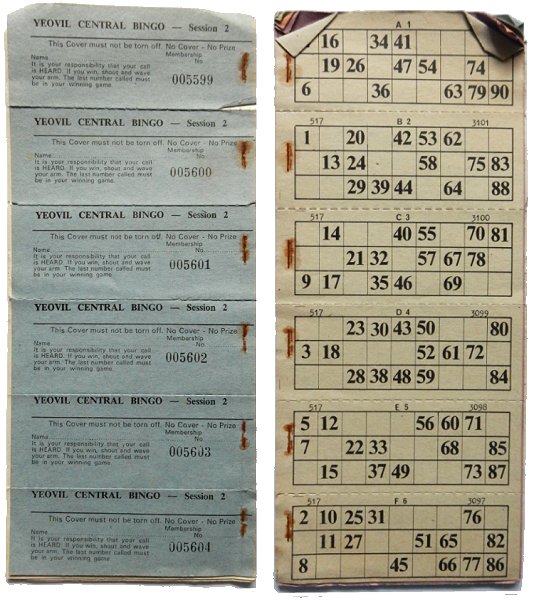
From my
collection
Both sides of a book of bingo cards from the 'Yeovil Central Bingo' of the early 1970s.
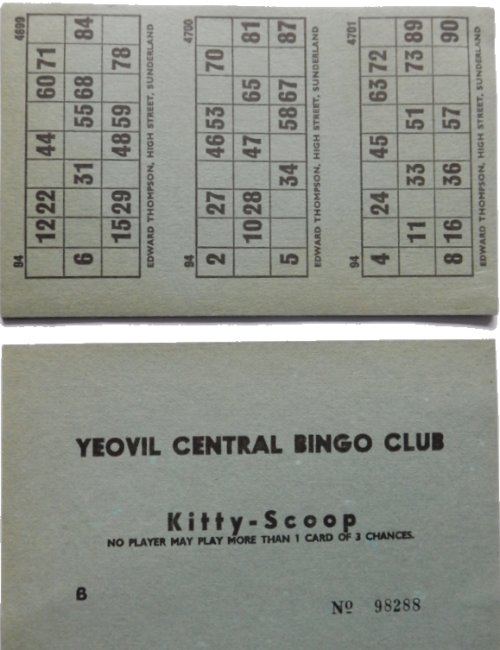
From my
collection
Both sides of a 'Kitty Scoop' bingo card from the 'Yeovil Central Bingo Club' of the early 1970s.
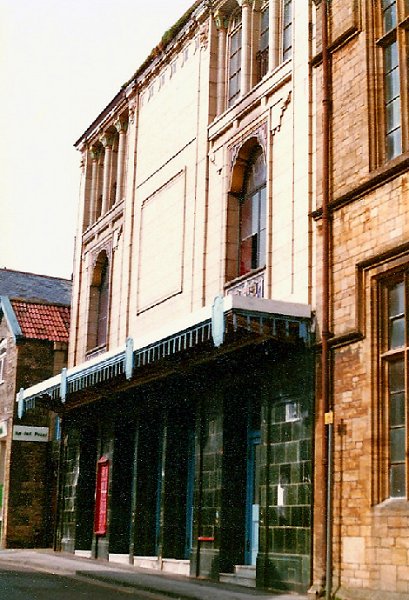
Courtesy of
Rob Baker
.... and seen from the eastern side of Church Street, showing the faience tiles.
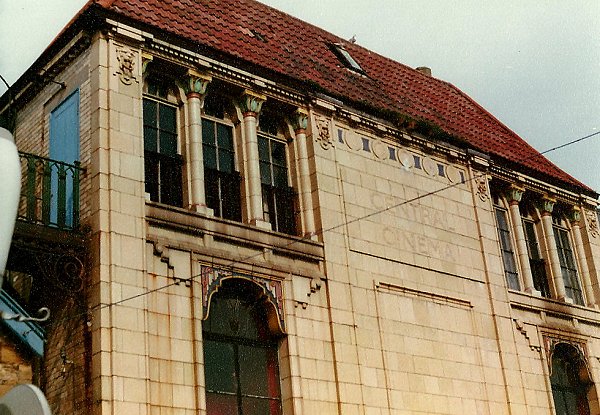
Courtesy of
Rob Baker
-
This photograph
features in my
book 'Yeovil
From Old
Photographs'
Detailing of the elaborate neo-Egyptian facade of the upper storey.
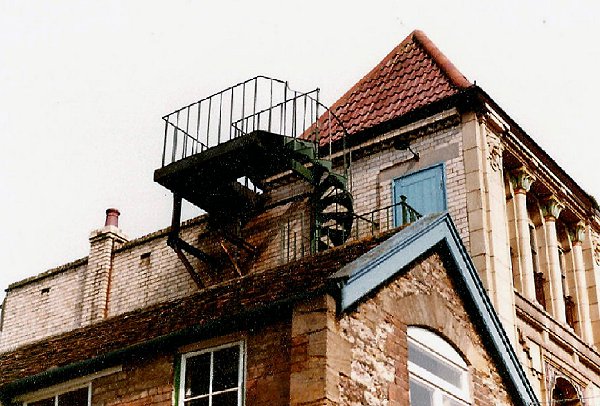
Courtesy of
Rob Baker
The only access for the projectionist to the projection room was via the external steel helical staircase and through the blue door.
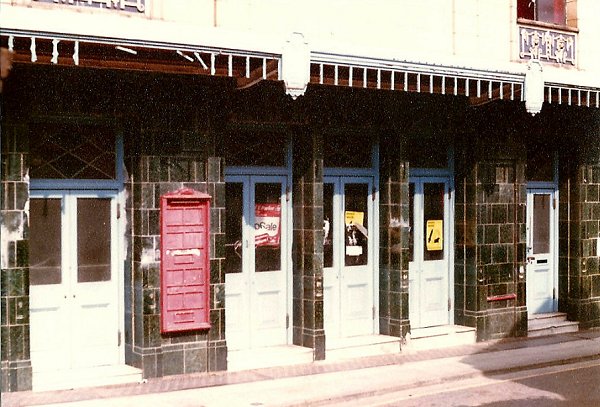
Courtesy of
Rob Baker
The ground floor entrances photographed in 1983. By this time the cinema had been closed for years and was awaiting demolition. Even the 'For Sale' sign in the door window was falling off.
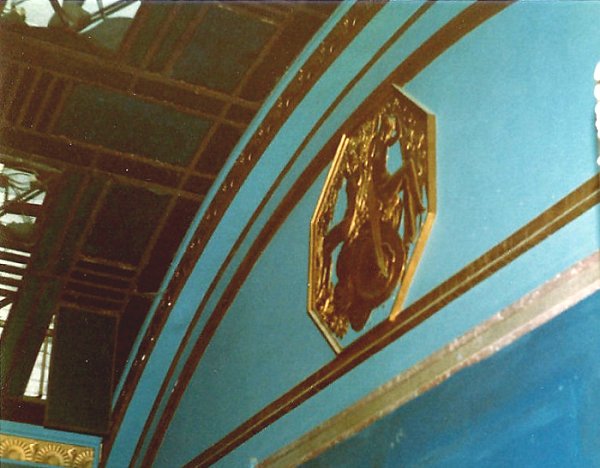
Courtesy of
Rob Baker.
This
photograph
features in my
book "Lost Yeovil"
An internal photograph glimpsing the decorative barrel ceiling and the end wall above the screen.
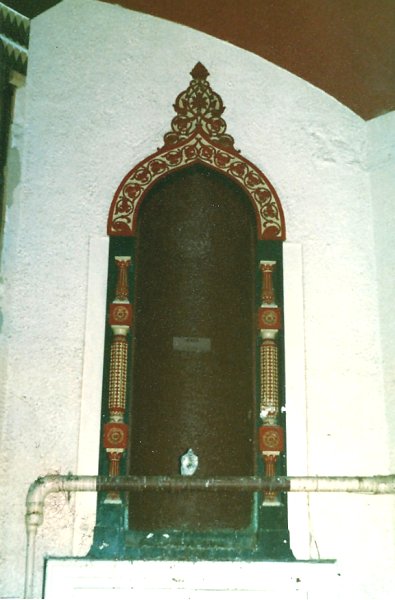
Courtesy of
Rob Baker
A decorative niche, typical of the lavish, oriental-style interior.
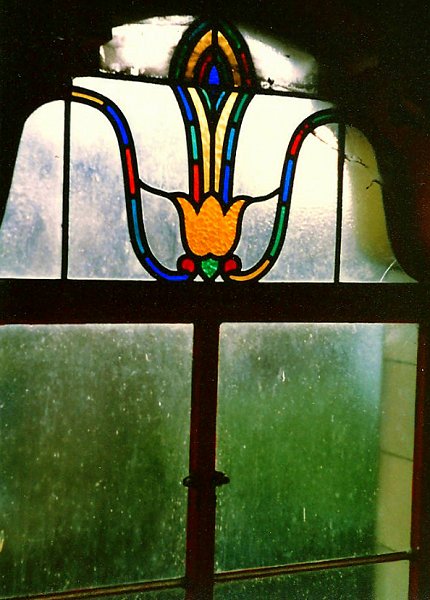
Courtesy of
Rob Baker
A detail of a stained glass window, again typical of the opulence of the building.
A series of Photographs by David Perry

Courtesy of
David Perry

Courtesy of
David Perry
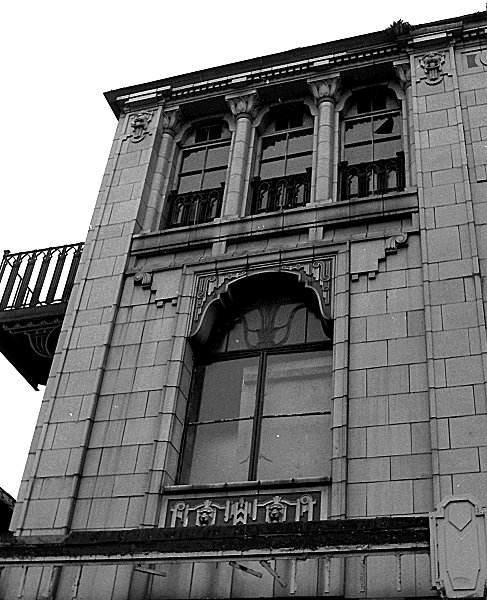
Courtesy of
David Perry

Courtesy of
David Perry
.... and then came demolition in January 1983
